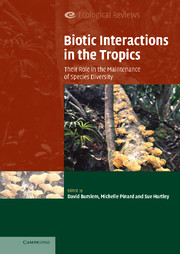Book contents
- Frontmatter
- Contents
- List of contributors
- Preface
- PART I Plant–plant interactions
- PART II Plant–microbe interactions
- PART III Plant–animal interactions
- PART IV Biotic interactions in human-dominated landscapes
- 18 The alteration of biotic interactions in fragmented tropical forests
- 19 Effects of natural enemies on tropical woody-plant invasions
- 20 New mix of alien and native species coexists in Puerto Rico's landscapes
- 21 The dynamics of a tropical dry forest in India: climate, fire, elephants and the evolution of life-history strategies
- 22 Changes in plant communities associated with timber management in natural forests in the moist tropics
- Index
- References
18 - The alteration of biotic interactions in fragmented tropical forests
Published online by Cambridge University Press: 25 August 2009
- Frontmatter
- Contents
- List of contributors
- Preface
- PART I Plant–plant interactions
- PART II Plant–microbe interactions
- PART III Plant–animal interactions
- PART IV Biotic interactions in human-dominated landscapes
- 18 The alteration of biotic interactions in fragmented tropical forests
- 19 Effects of natural enemies on tropical woody-plant invasions
- 20 New mix of alien and native species coexists in Puerto Rico's landscapes
- 21 The dynamics of a tropical dry forest in India: climate, fire, elephants and the evolution of life-history strategies
- 22 Changes in plant communities associated with timber management in natural forests in the moist tropics
- Index
- References
Summary
Introduction
Tropical rainforests are renowned for their ecological complexity and the seeming ubiquity of coevolved relationships among species (Janzen 1969; Gilbert 1980). Unfortunately, these forests are being destroyed and fragmented at alarming rates, to the extent that many tropical protected areas are becoming virtual islands in a sea of heavily degraded land (Laurance & Bierregaard 1997; DeFries et al. 2002). The future of tropical biodiversity will be largely determined by the extent to which natural ecological processes and communities can be maintained in isolated fragments of forest.
Here I summarize available information on the alteration of biotic interactions, such as predation and key symbioses like pollination and seed dispersal, in fragmented tropical forests. This review is necessarily preliminary, given the great diversity of species and ecological interactions in the tropics and the fact that the alteration of biotic linkages is among the most poorly understood consequences of habitat fragmentation.
Initial impacts of fragmentation
Forest fragmentation leads to the reduction and isolation of remnant forest patches. Although each fragmented landscape is unique, a common pattern is that most forest fragments in human-dominated landscapes are small, ranging in size from a hectare or less to a few hundred hectares (Gascon et al. 2000; Cochrane & Laurance 2002). The biota of such small forest patches are expected to be vulnerable to edge effects and many other negative consequences of fragmentation (e.g. Laurance et al. 1998, 2002).
- Type
- Chapter
- Information
- Biotic Interactions in the TropicsTheir Role in the Maintenance of Species Diversity, pp. 441 - 458Publisher: Cambridge University PressPrint publication year: 2005
References
- 7
- Cited by



